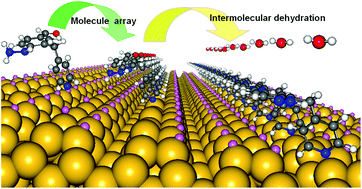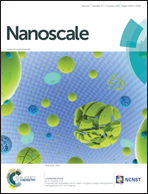A theoretical guide for fabricating a conductive molecular wire on a silicon surface via an in situ surface polymerization reaction†
Abstract
It has been a long-standing goal to make conductive molecular wires or linear polymer chains on traditional semiconductors or insulator substrates to satisfy the ongoing miniaturization in electronic devices. Here, we have proposed a surface in situ polymerization reaction for a pre-absorbed molecule, 4-hydrazinyl-3-(pyridin-4-ylmethyl)-benzaldehyde (HPyMB), to produce a conductive molecular wire on a silicon surface. Our first-principles calculations show that HPyMB molecules can absorb alternatively on the exposed Si atoms created via ultrahigh vacuum scanning tunneling microscopy on a hydrogen passivated H–Si(001)2 × 1 surface along the [110] direction. The adsorption is exothermic and its generated energy is sufficient for the following intermolecular dehydration polymerization reaction to overcome the activation energy barriers and thereafter form a molecular wire on the surface. This polymerized molecular wire is mechanically stable since it is chemically bonded onto the surface. After polymerization, the system becomes conductive due to the charge transfer from the molecule–surface bonds to their pyridine rings. More importantly, by removing 1.1 electrons from the system, the surface polymer chain is the sole conductive channel. Furthermore, its conducting nature remains robust even under a large external electric field. Our findings open a new window for the fabrication of conductive molecular wires or polymer chains on semiconductor surfaces, and provide insights into the mechanism behind the molecular wire conductivity.


 Please wait while we load your content...
Please wait while we load your content...